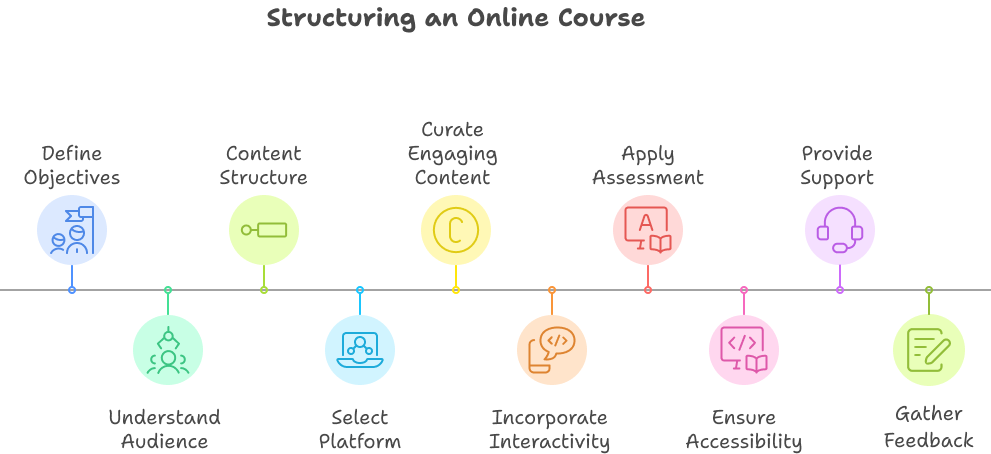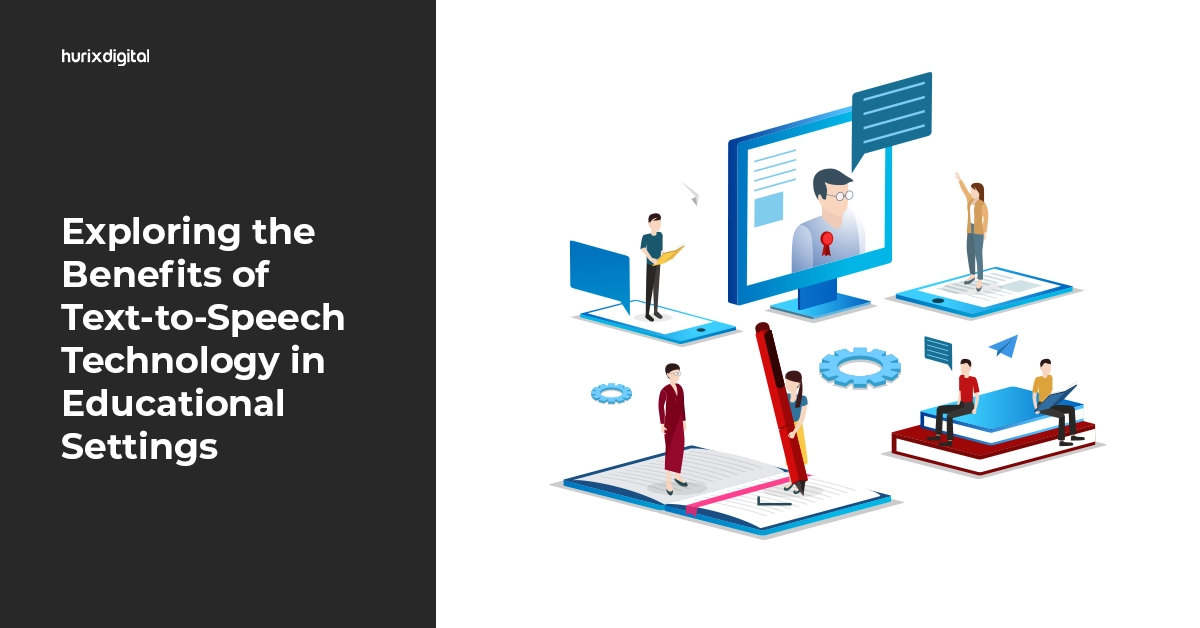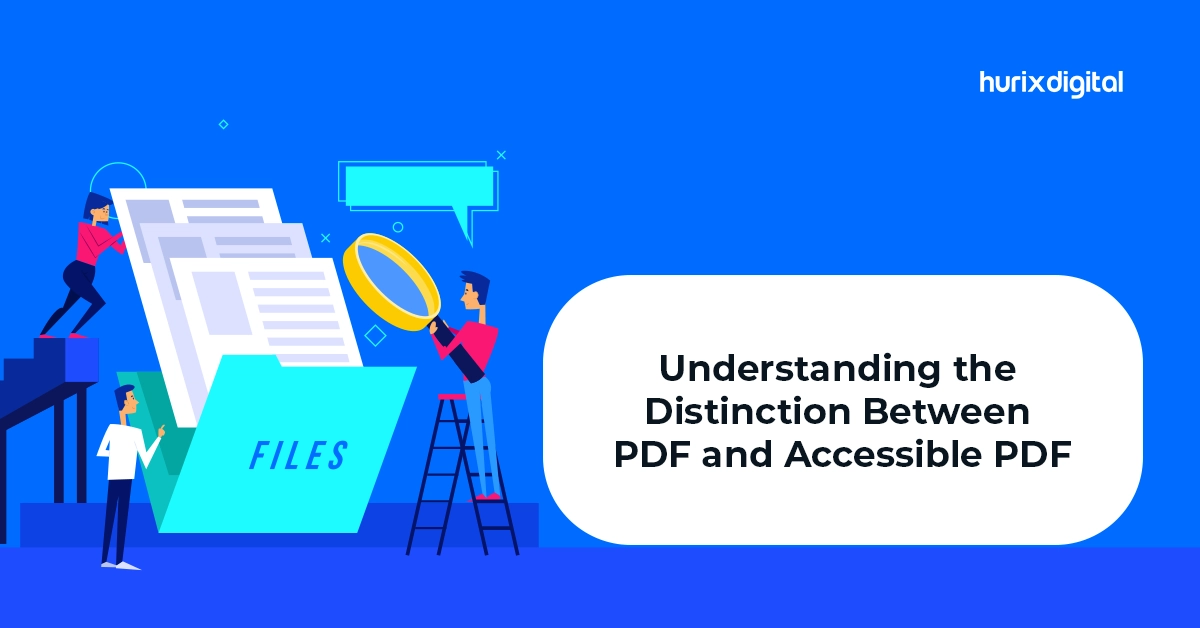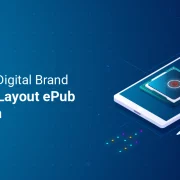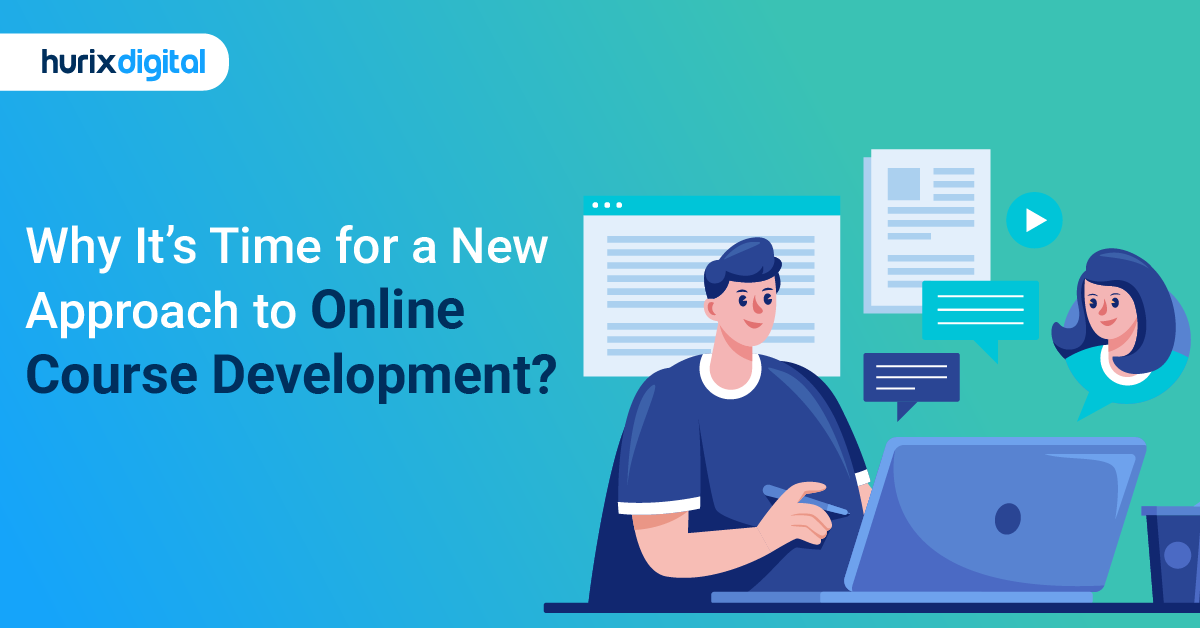
Why It’s Time for a New Approach to Online Course Development?
Summary
This blog discusses a new online course development model, blending central and decentralized methods, focusing on collaborative design, unique elements, and AI integration to enhance eLearning experiences.
Modern technology has revolutionized the educational sector. Marked by an increasing shift from traditional learning methods to eLearning models, the educational online industry has been witnessing rapid growth. According to a market report, the global eLearning market is set to reach $848.12 billion by 2030, expanding at a CAGR of 17.54%. It indicates that the need for eLearning courses is on the rise. This is where online course development steps into the picture.
However, online education also comes with its own set of challenges. One of the biggest challenges is how to structure your online course in a way that facilitates effective learning and delivers positive outcomes. Unlike traditional classroom settings, online courses require more planning, design, and organization to ensure learners stay motivated, engaged, and satisfied throughout the course.
In this blog, we will share strategies for overcoming challenges with online classes and enhancing your learning experience with course development models.
Table of Contents:
- What are Online Course Development Models?
- Central Design Model for Online Course Development
- Advantages of Central Design eLearning Model
- Challenges of Central Design eLearning Model
- Decentralized eLearning Model for Online Course Development
- Advantages of the Decentralized eLearning Model
- Challenges of the Decentralized eLearning Model
- Laying the Foundation of a New Online Course Development Model
- Ten Steps on How to Structure an Online Course
- Need for a New Online Course Development Model
- Conclusion
What are Online Course Development Models?
Online course development refers to a systematic process of planning, designing, organizing, and sequencing course content to deliver effective eLearning experiences over the Internet. It also involves selecting suitable educational technology, developing multimedia elements for student engagement, and creating assessments for reviewing student performance.
Educational institutions use the course development model to design and implement an eLearning course and achieve the desired learning outcomes.
As mentioned above, two popular approaches are followed for eLearning course development. They are:
- Central Design Model
- Decentralized Model
Both approaches have advantages and challenges. Let’s take a look at them.
Central Design Model for Online Course Development
The central design model for course development involves creating a single course followed by several online educational institutions offering remote or distance learning solutions. This eLearning model has been in use for more than twenty years now.
The design structure involves an efficient team creating a course shell. Such a team often includes an instructional designer, a subject matter expert, a course builder, a copy editor, a media designer, and a few other experts.
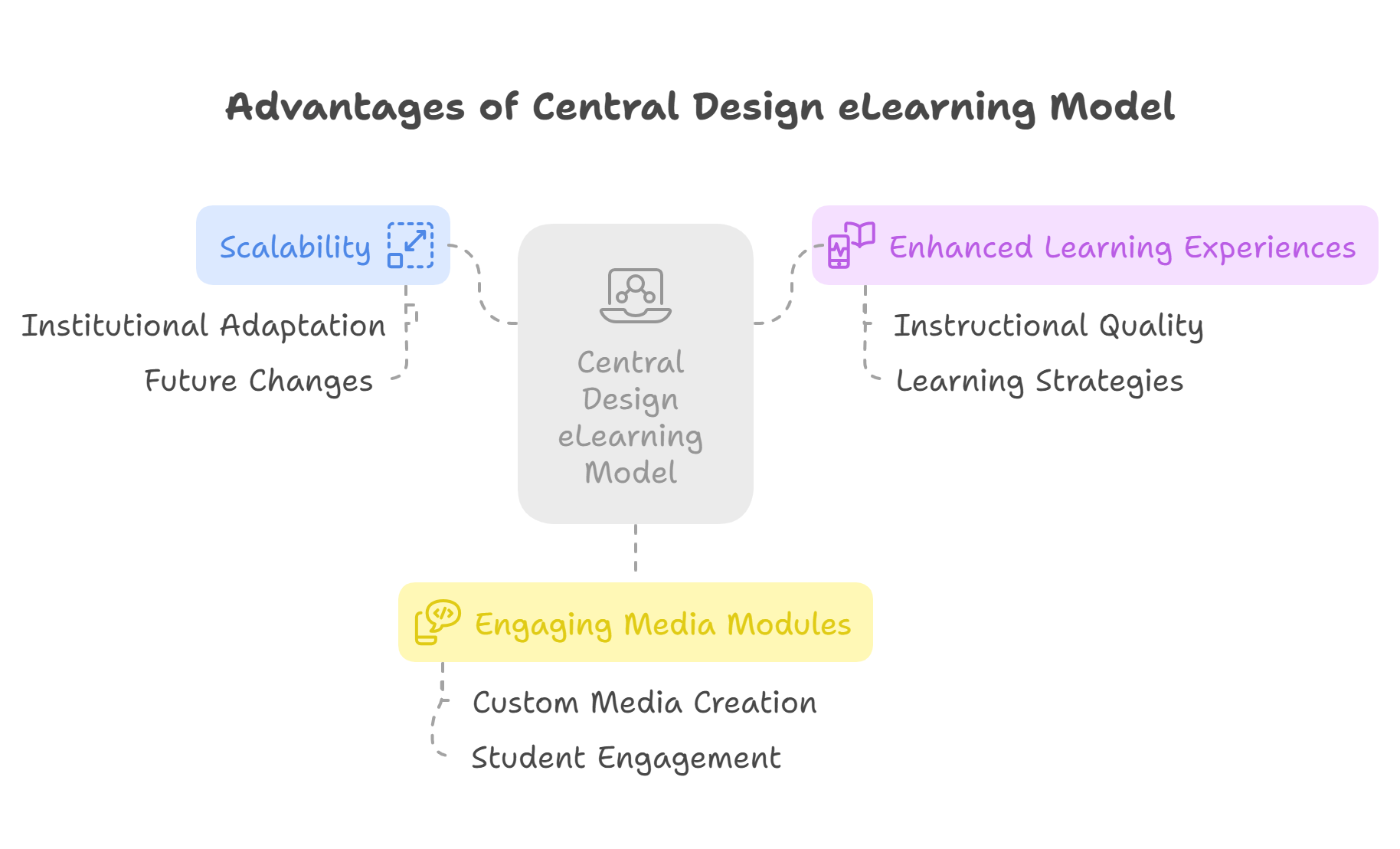
Advantages of Central Design eLearning Model
This course development model offers multiple advantages. Some of the major advantages include the following:
1. Scalability
The central design model allows educational institutions to scale based on their requirements. It’s an innovative curriculum design feature that helps institutions adapt and expand the course or make changes seamlessly in the future.
2. Enhanced Learning Experiences
This model attaches great importance to instructional quality. A common feature is that it maps course content and assignments to learning outcomes. It uses various learning strategies, such as cognitive primers, authentic assessments, etc., to deliver enhanced learning experiences.
3. Engaging Media Modules
Media plays a crucial role in a central design model. It facilitates the creation of custom media pieces using various kinds of authoring tools, such as scenario-based interactives, animation, talking heads, etc. It’s one of those digital education trends that engages students and encourages them to participate actively in the course.
Challenges of Central Design eLearning Model
The course development time can often extend to 3 or 4 months, based on the length of the course. What’s more, the development time required for a short-term course of around 6 to 8 weeks and an extended course of around 6 months may vary by just a few weeks.
Decentralized eLearning Model for Online Course Development
Traditional educational institutions that have started developing their versions of online courses often prefer the decentralized model. As the name indicates, it involves each educational institution designing distinct courses rather than following a single centralized course.
In this course development model, the professor or teacher plays a significant role. The design structure is tailored to meet learners’ distinct interests and requirements.
Compared to the centralized model, the curriculum innovation offered by this model allows for more flexibility in determining the course content, goals, and assessments.
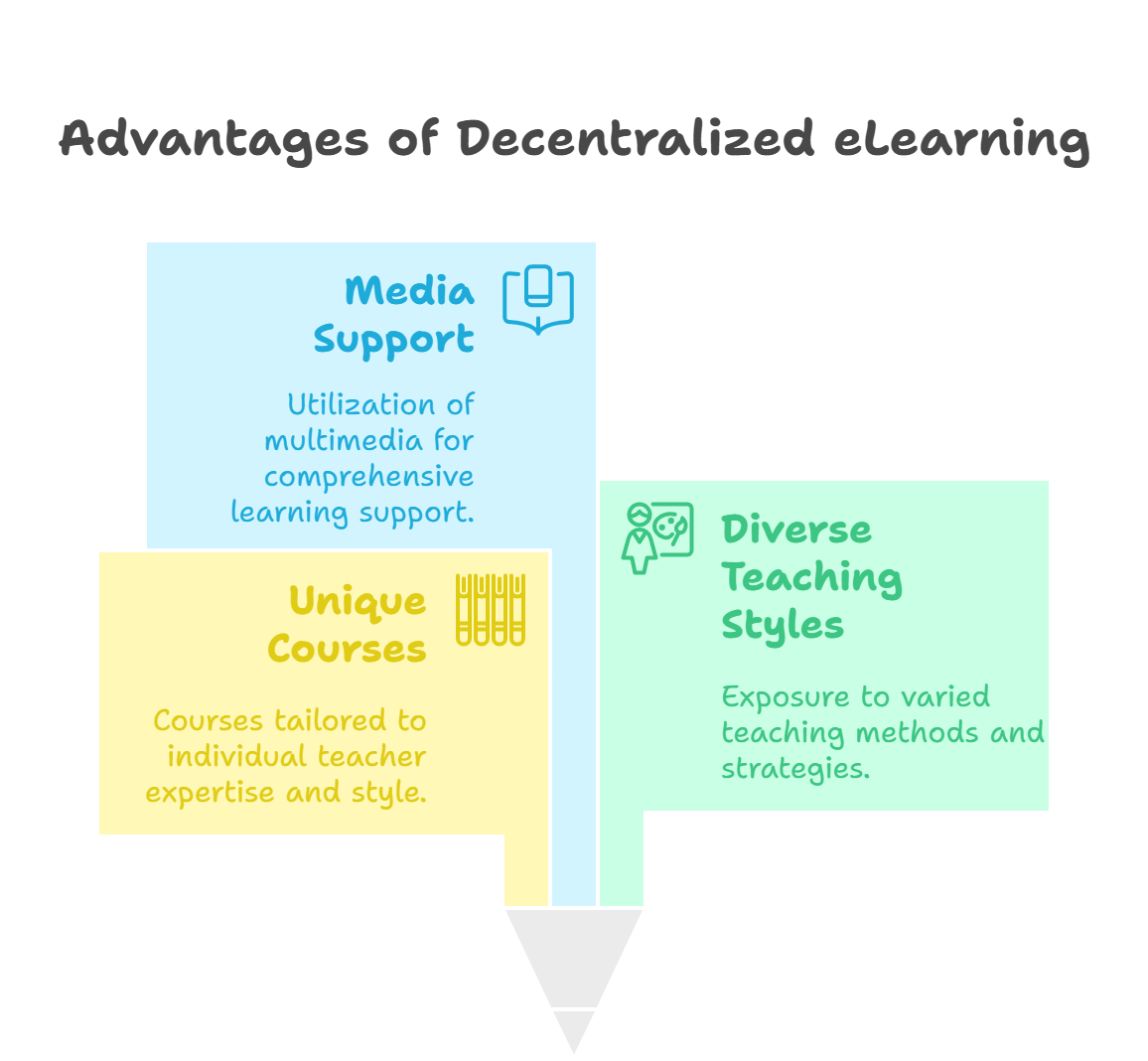
Advantages of the Decentralized eLearning Model
The decentralized model comes with its own set of advantages. Among the top advantages are the following:
1. Unique Courses
This model allows teachers or professors to design courses that match their research areas. Each course reflects the personality of the teacher or professor who developed it, offering students various options when selecting an online course.
2. Diverse Teaching Styles and Strategies
This decentralized model enables each teacher to bring along his or her unique teaching style. So, students opting for decentralized courses can be exposed to different teaching approaches.
3. Media Support
For this eLearning model, the course instructors or faculty often create video lectures spanning several hours to disperse learning materials. They even leverage online videos or library content to help students understand their course content.
Challenges of the Decentralized eLearning Model
One of the biggest challenges of this model is that the courses may differ in quality as different individuals prepare them. Further, in this model, one course is used by one teacher or professor. It poses a huge problem for an institution with limited resources and budget for online course development.
Another challenge is that the course instructors often rely on creating videos to deliver content to the students. Long video lectures can fail to engage students, and they may lose interest in their lessons.

Laying the Foundation of a New Online Course Development Model
The models above have their advantages and disadvantages. We need a new model to overcome these shortcomings and offer more enriching learning experiences.
A new online course development model must have attributes and features outlined below to keep pace with trending changes in the education sector:
1. Collaborative Approach to Course Development
In the decentralized model, the designed course’s efficiency, quality, and appeal suffered because the faculty professor exercised his discretion in excess. This also protracted the time for the course to be deployed. Further, the course developed by one faculty is solely used by them to enlighten students without considering whether the learners like it or not.
In the new model, the focus should be on enhancing the educational experience of learners by shifting away from strictly faculty-centric videos. Universities should constitute a course development body that will ensure that adequate time, budget, and resources are allocated for creating immersive courses with a variety of content.
A diverse range of teaching strategies and multimedia elements should be incorporated to dwell on each topic more attention-engagingly. This will improve retention and outcomes.
2. Incorporation of Unique and Differentiating Course Elements
In online curriculum development, the developers often fall into a rut, evident from the feel and look of the final content. With monotony, the differentiating perspective usually takes a backseat as consistency and speed take priority.
In the new model, each course should be integrated with differentiating aspects to make topic exploration more engaging and rewarding. This can be accomplished by incorporating variegated media that will bear the stamp of instruction and media designers’ talent.
More emphasis should be on leveraging cutting-edge authoring tools from online learning platforms to take course customization to the next level. Scenario-driven interactive elements, animations, talking icons, etc., can enliven any course.
3. Better Adoption of the Rotational Model
Students’ continuous exposure to different learning environments can improve the efficacy of online courses. For this, the online course has to be developed in an accommodative manner to rotate learners through varying environments.
The learning needs of students should be precisely defined for this purpose. Next, the online module should be segmented to intermittently support idea generation, group discussions, independent learning, and teacher-led training. Provision must be made for seamless switching between in-person instruction and online learning.
This blended learning approach will better serve the purpose of eLearning, as individual needs can be diligently focused upon, and students can be exposed to different academic experiences throughout.
4. More Focus on Enriched Virtual Model
The new online course workflow should factor in the enriched virtual model paradigm. Web-based or online learning platform-driven courses can be strategically interspersed with video conferencing, chatrooms, and other modes of virtual classrooms. This will help learners gain insight into instructional materials through real-world knowledge assimilation options.
A new dimension can be added to conventional online learning with virtual tours, video conferencing, virtual simulations, etc. Learners can exchange views with instructors and peers in a collaborative environment while enriching themselves intellectually in a self-paced learning mode.
5. AI Should Remain at the Forefront
The static online learning modules will soon lose relevance as AI ushers in better technology-leveraged curriculum innovation. Improvements to the online course for optimizing the curriculum should not be a long-drawn affair. AI will help enhance training efficacy by incisively analyzing students’ learning patterns, existing skills, interests, and assessment outcomes.
The inputs from AI-based recommending systems have to be evaluated to tweak the online course workflow and frame new chapters for better skill refinement. The translation tools powered by AI should be incorporated into eLearning modules to increase their outreach.
The online learning platform must be equipped with natural language processing and speech recognition tools to promote optimum interactivity using voice. Further, the excess time taken to create online courses can be decisively cut short by using AI to tailor learning experiences using tools and information available in knowledge databases. Adaptive learning must be prioritized.
Check out EXCLUSIVE: Hurix Minibook: Immersive Learning for the WIN in Education!
Ten Steps on How to Structure an Online Course
When creating an online course, it is essential to start by clearly defining your objectives. This will not only guide the content you develop but also help your learners understand what they can expect to achieve by the end of the course. Setting specific, measurable goals will ensure the course remains focused and effective.
1. Define Your Objectives
Start by asking: What should learners learn? Is it mastering the art of spice blending or understanding regional cuisines? Set clear and measurable goals: “Learners will demonstrate the ability to prepare and present three regional Indian dishes, assessed through video submissions.” This will help you structure your course effectively. Use Bloom’s Taxonomy verbs like “demonstrate” to define actionable learning outcomes.
2. Understand Your Audience
Are your learners’ culinary novices or seasoned foodies looking to explore Indian cuisine? For beginners, you might start with the basics of Indian spices, while more experienced cooks could dive into regional specialties. This step is crucial for tailoring the content to meet their needs. Tools like Google Forms can gather insights, while Xtensio can help create detailed learner personas.
3. Content Structure
Lay out your course like a well-organized recipe book. A well-structured course guides learners through a logical progression of topics. Each lesson builds upon the previous, from understanding basic spices to mastering complex dishes. Start with an appetizer – an introduction to Indian cuisine. Follow with lessons on key ingredients, cooking techniques, and regional dishes. Feature case studies, like how biryani varies from region to region. Include practical applications, such as planning an Indian dinner party. It’s about organizing your material logically, coherently, and engagingly.
4. Select the Right Platform
When selecting a Learning Management System (LMS) or eLearning Platform for your course, consider its user interface, ease of navigation, and tools for tracking student progress. Ensure it aligns with your course’s objectives and teaching style. Platforms like Udemy or Skillshare, known for their robust multimedia support, can be ideal for a visually rich subject like cooking.
These platforms allow for high-quality video uploads, which are essential for demonstrating the skills that the learner has gained on the course. They also have engaging interactive elements like quizzes and discussion forums. Learners can also upload their work, including photos or videos. This helps learners apply their knowledge, receive feedback, and chat with classmates.
5. Curate Engaging Content
Creating material involves not only delivering informative content but also making it captivating. By integrating a variety of formats, such as text, videos, infographics, and podcasts, the content can appeal to diverse learning preferences, ensuring it is both educational and engaging. For the cooking course, you can use Canva to design graphics explaining spice combinations or Vyond to create video tutorials for dishes using animation.
Incorporate storytelling into your course content. Share the history behind dishes, anecdotes about regional cuisines, or personal cooking experiences. This approach helps in creating a more relatable and immersive learning experience.
6. Incorporate Interactive Elements
Adding interactive bits like quizzes, chats, and hands-on simulations brings your course to life. It’s all about getting your learners involved instead of just reading. For quizzes that grab attention, Kahoot is your go-to. Need to build some cool interactive simulations? Give Articulate Storyline a whirl. And for your cooking course, turn your kitchen into a virtual classroom with live Q&A sessions on Zoom. It’s a fun way to make the learning stick and keep everyone on their toes!
7. Apply Effective Assessment Strategies
This involves using a mix of formative and summative assessments to evaluate and reinforce learning based on the learning objectives you defined in Step 1. Assess your learners with practical tasks, like preparing a specific dish. Use Turnitin to check any written recipe assignments for originality. Peer assessments can also add a layer of community learning, where learners can share feedback on each assignment. Tools like Peergrade or built-in LMS features can facilitate this process, fostering a sense of collaborative learning.
8. Ensure Accessibility
You must ensure your course is accessible to everyone, including individuals with disabilities. For this, adhere to the Web Content Accessibility Guidelines. Incorporate alternative texts for all images to provide descriptive information about the visuals for those with visual impairments. Include subtitles in your cooking tutorials and offer transcripts to your podcasts. Utilize tools like Amara for creating subtitles, making sure that every learner can fully engage with and benefit from your course.
9. Provide Continuous Support
It is about being available to your learners throughout their learning journey. It includes offering feedback, conducting Q&A sessions, and facilitating community forums. For example, what if your learners want to ask you how to substitute ingredients or adjust flavors? For this, you can set up weekly virtual office hours or create an interactive community on Slack for personalized tips or troubleshooting.
10. Gather Feedback and Iterate
Use SurveyMonkey to collect feedback and track engagement on your course. Did learners find the Masala Dosa tutorial helpful? What about the spice blending exercise? Use this feedback to refine your course, adding more chutney recipes or a module on street foods perhaps! This step is crucial for keeping the course relevant and effective.
Need for a New Online Course Development Model
Both central design and decentralized course development models offer distinct advantages and challenges. The central design model attaches a lot of significance to the systematic planning and designing of a course. In contrast, the decentralized model prioritizes the needs and interests of learners.
As technology continues to evolve, the need today is to develop online courses that can address a student’s specific learning needs. At the same time, this need should be addressed through a high-quality course planned and developed by a team of experts handling specific aspects of course development.
This leads to the need for a new online course development model that can incorporate the plus points of both approaches and eliminate or minimize the challenges extended by these models. Such a hybrid course development model will help students reap the advantages of both models and enhance their learning outcomes.
Conclusion
Structuring your online course is crucial in creating a successful and impactful online learning experience. By following the six strategies we shared with you in this blog, you can optimize your online course structure and enhance learning outcomes.
However, structuring your online course is not a one-time task. You need to constantly review, update, and refine your course structure based on learner feedback, emerging online education trends, and instructional design advancements.
If you want to learn more about creating effective and engaging online courses, check out Hurix Digital. Hurix Digital is a leading provider of online learning solutions that can help you optimize your online course structure and enhance learning outcomes.
Contact us today to learn how we can help you achieve your online learning goals.

Senior Vice President – Business Development
Over 25 years of experience in the edtech and workforce learning industry with strong skills in Business Development, Customer Relationship Management (CRM) and Strategy.

